Emphasis on Palm Trees, Cycads and Companion Plants
by Phil Bergman
Includes Information on Water Conservation and Species
Creating a beautiful garden is the goal of many, and there are multiple garden themes one may follow to landscape the garden. Which landscape design or theme you select depends on your tastes. Some people prefer a formal, symmetrical garden with emphasis on flowering plants like roses and annuals. Some like the alpine look of Pines, Fir and Rhododendrons. Others prefer an arid desert type of landscape. Many (if they could), would choose a lush tropical landscape garden. All garden-themes have their own appeal. Below is a discourse on the creation and design of a tropical to semi-tropical landscape with an emphasis on palm trees, cycads and tropical companion plants. We’ve added recently comments on water conserving plants and different species.
Introduction
We are not going to discuss structure or hardscape, but rather the plants, with some emphasis on the species one might choose for a great tropical landscape. But, first one must come up with a concept of what they are trying to create. And, in doing this, there are many things to consider. The plants you select and how you place them is very important. Remember, the garden is mostly about the plants. We will be showing you photographs of gardens to give you ideas about what you could do in your garden.
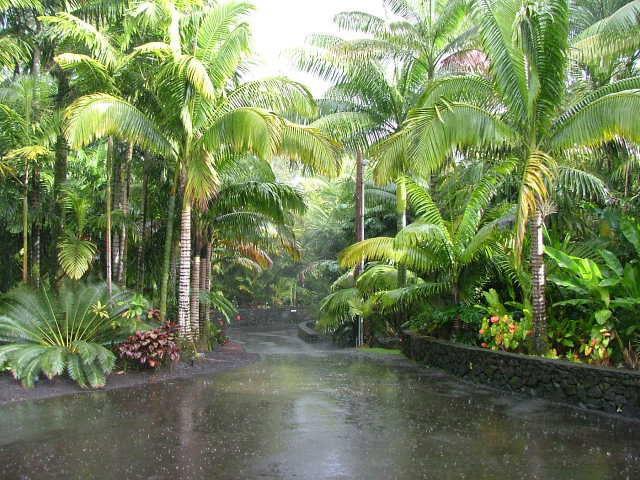

GUIDING PRINCIPALS
There are a few guiding principals which I would like the readers to consider as they review this article and pursue their landscape design:
Decide what type of landscape design you want to create
Do you like tropical landscaping, this article very much applies to you.
Plan ahead and select your plants wisely
Decide which species will give you the desired landscape design you seek.
Don’t just buy what’s available commonly and not choose what you really like
Utilize different species that add character to the garden. Don’t let your gardener steer you to common plants from the box stores.
Decide on the general design and density of planting that you’d prefer for your garden.
Below I will give options on density of planting. Decide which you prefer. Then develop a general design that meets your needs.
Choose palm species that are possible for your specific growing area
Given reasonable growing conditions, realize that anyone can create a beautiful tropical garden, but species chosen must be able to survive in your area. Otherwise, you lose all your plants in the first cold winter simply because of poor choices.
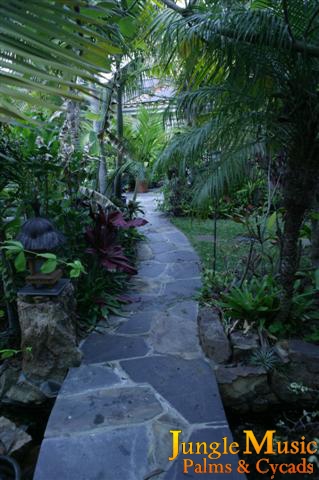
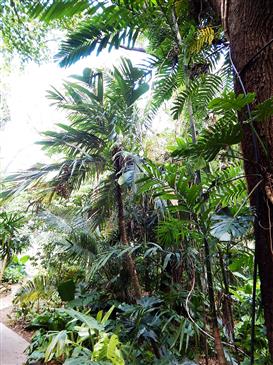

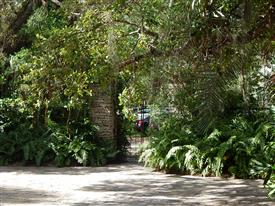
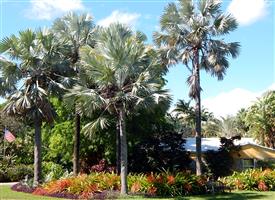
Remember to plan for different layers of plants in your garden
Most people use a three layer design: small things close to walkways, then medium sized plants and tall, canopy-forming species for the outer areas of your design.
Use companion plants to add beauty to your garden and give color
This is super important and instantly adds charm, color and appeal to the garden. There’s so many plants to pick from.
In special areas, use palms that accentuate and beautify the hardscape.
One might want a curved trunk species reaching out toward a pool, or a tall columnar trunk palm next to a walkway or a suckering palm to block a neighbor’s view into your yard.
Find solutions for those “difficult areas”
There’s always a solution for every difficult or problem area. This is an area where an expert (like us) might guide you.
Place individual plants correctly.
Palms and cycads are predictable. You know before hand what they’ll eventually look like. So, plan and plant accordingly.
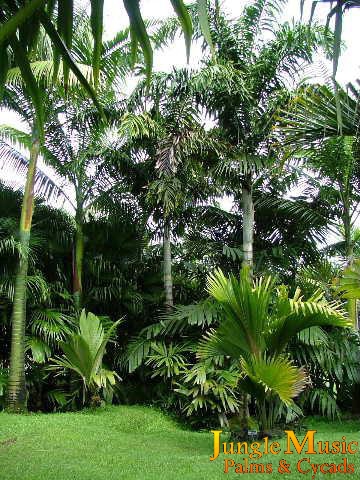
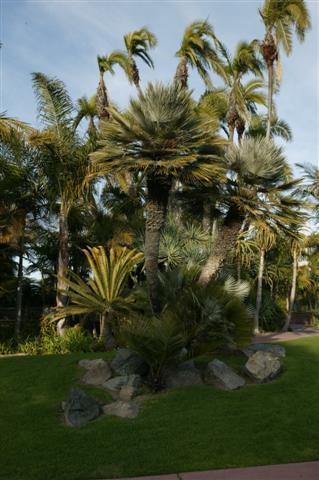

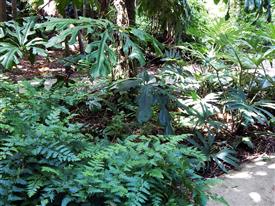
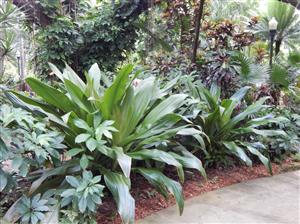
Your Locality & Growing Conditions
If you like the looks of a tropical garden, you must take a realistic look at is your local growing conditions. How cold do you get? Is it extremely dry? It’s very difficult to create an outdoor tropical garden if you live in the cold central areas of the United States or in a mountainous area that sees long cold winters. Likewise, hot and dry areas present their own problems with your garden landscape design. There are articles elsewhere at this Site that deal with such issues. If cold weather is a concern, here’s a link to our Cold Hardy Palm Species. I think it’s the best presentation on the Internet on this subject.
As certain palms or other plants not tolerating winter low temperatures is such a big problem, please read the article above. Always consider how cold any given species can tolerate. This article presented here is aimed at conditions one might see in Southern California with it’s mild climate. But, concepts below are applicable to other areas whether you live in South Texas, Florida, Hawaii or far into the Tropics. We will show a few pictures from areas outside Southern California. The only difference in design is which species you select for growing in your garden. One way or another, there is a way you can do tropical landscaping in your area.
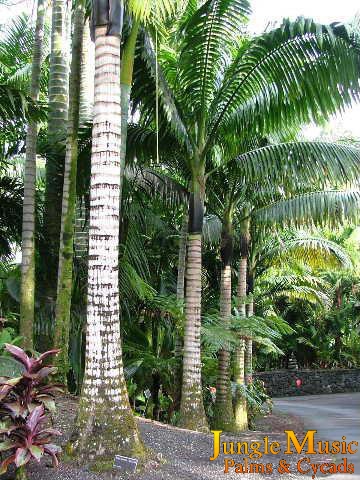
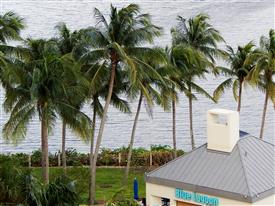
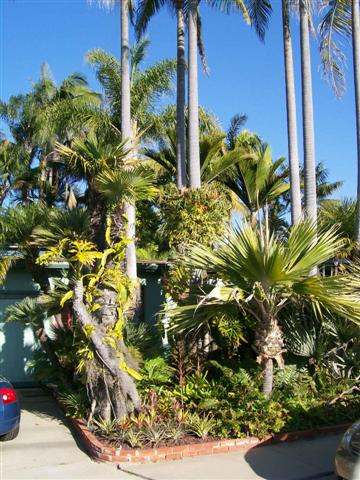
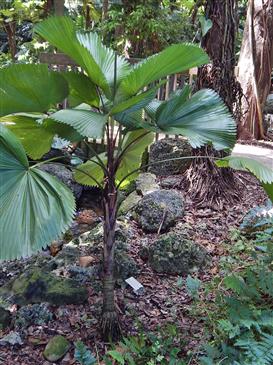
Planning Ahead
Most people start with their hardscape design and installation. This means you put in the pool and decks before you plant.
This is not absolutely necessary, but is the most common practice. But, planning ahead for your plantings is critical.
Often a landscape designer or architect is hired to come up with a basic plan regarding the structural aspects of your garden. His or her main contributions will include the design of features like a pool, fountains, walls, walkways, decks, water features, irrigation, etc. And, such an architect might select and specify species of plants for you. If you know that you want a tropical garden, it is best for you to select a professional who has experience with the tropical types of plants that you like. Designers and architects may have their own personal preferences that they recommend and these might not match your goals. Or, they might have limited knowledge about palms and cycads. So, either hire a designer with experience with these plants or do research on your own. And, insist that beautiful species are utilized in your plans. Often commonly available plants like Queen Palms, Pigmy Dates and Sago Palms are all that is called for to lower costs and because these might be the only species a designer knows. Demand otherwise or buy your own plants and have them installed after you select them. Once you’ve signed for a contractor to provide and plant the common species, it’s often difficult or expensive to alter the plants when the day comes for installation of the soft-scape material. So, plan ahead and you’ll get that tropical garden that you want.
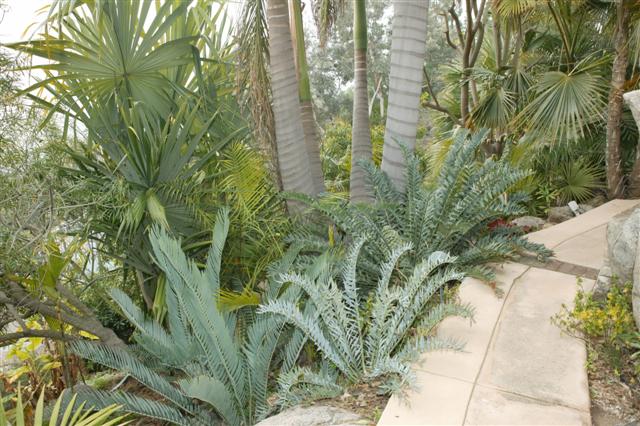

Getting Started
Now, let’s jump forward and assume that your basic hardscape is done. Perhaps you bought a house with a pool, deck and sprinklers. Lets say these items are there but everything looks sort of plain and “empty” with no nice plants. Or, perhaps you hired someone to install the hardscape and now you are ready to plant. Or, it’s just a “backyard” that you’ve never landscaped. It doesn’t matter. It’s what you do with it now that makes all the difference in the world. It’s the plants you select and how you plant them that will determine the eventual beauty of your landscape.
The exact same yard with the same hardscape can either become gorgeous or remain boring just based on the plants that are selected and put into the yard. So often people spend a small fortune on the hardscape and then save money at the tail end of their project by skimping on the plants. This is quite a mistake because the plants are what really makes the landscape beautiful and are (typically) a small fraction of the overall cost of the project.
My point here is to use the same diligence in selecting your plants as you did to select the beautiful tile around your pool. You really can turn a boring yard into a tropical paradise with the right plant material and basic horticultural care. And, you can make that landscape project “look like a million bucks” with the right selection of plants.
With these things in mind, hopefully by now I’ve at least put the idea that anyone can improve the looks of their yard by just putting a little effort into what they are doing and by selecting the right material to plant. So, let’s begin talking about specific topics and give you ideas of how you can change your “yard” into a unique and beautiful “garden”.
Density of Planting In the Garden
How far apart does one space the plants?
Major variables in planting out the garden include:
1) Selection of species to plant
2) Creation of vertical height to the garden (a variable of the species you select)
3) Placement of specimens and
4) Density of planting (discussed below)
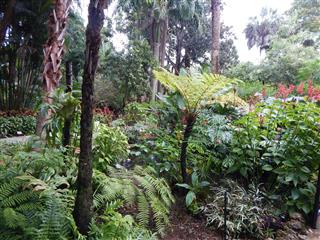
Minimalist Approach with Just A Few Tropical Plants
Let’s first talk about density of planting. There are a lot of approaches to density. One might want a very minimalist type of garden with a no or very few plants here or there. Minimalist gardens often have expansive areas of lawn or simple ground cover over these areas. If you really want this type of garden, do consider a stately palm to break up the monotony. I say this because most people find a yard of simply lawn or dirt to be very unappealing. Certain Phoenix species, Bismarckia, Jubaea, and others would vastly approve a minimal landscape. But, be aware that one huge plant in the center of the yard can be a bit boring. In contrast to this, one can do a central planting of a larger species and then complement this with perimeter plantings closer to the house or fence. And, one can put companion plants like smaller cycads, Philodendron, Alocasia, etc. near the base of the larger plants to add interest. It is quite common to see homeowners pay dearly to crane in a few big Canary Island Palms. But, without additional plants to offset the magnitude of the big Canaries, the yard looks out of balance and is not really appealing. So, be careful if you just plan to put in “one big palm”.

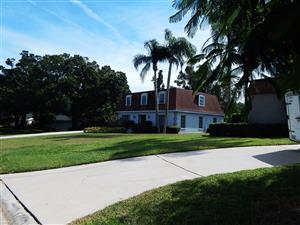
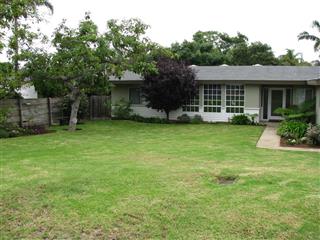
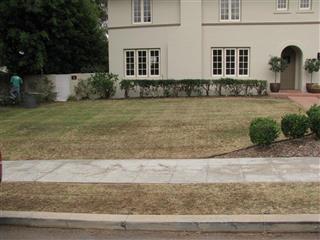
Photos above of what I would call “minimal landscape”
Lightly Planted Tropical Gardens
This approach is commonly seen in our areas of Southern California. This includes some plants next to the house and driveway with scattered plants elsewhere, typically along the fence or perimeter of the yard. To most eyes, such gardens are more appealing than the “minimalist” garden discussed above. With the right choice of species, this approach can be appealing and not overwhelming to the homeowner. It would be considered easy maintenance and preserves space for a lawn or other features. One must still choose interesting species to add character to the yard. If one has deck areas, tropical plants can be added to decorative pots.
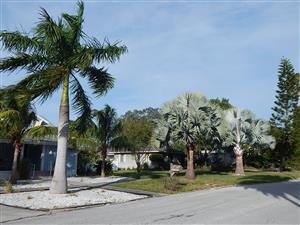
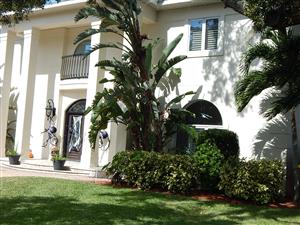
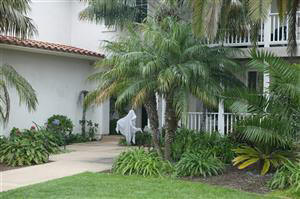
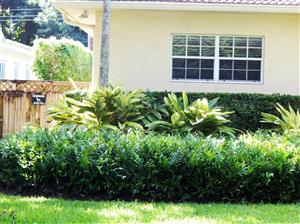
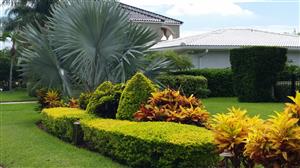
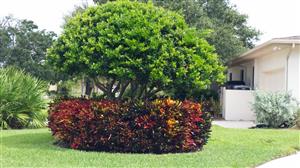
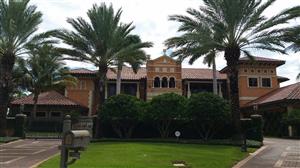

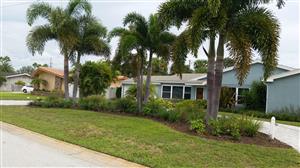
More Densely Planted Tropical Gardens
Now imagine a garden that is planted either medium or heavy in terms of density of plants. It is designed like a botanical garden with more emphasis on the plants than the lawn and utilizing a good variety of species. Often lawn areas are minimal (reserved for accent or viewing) or eliminated altogether. One might imagine that such gardens are more maintenance, but when you eliminate the need for mowing and edging, less maintenance may result. Such gardens do not have to be “a jungle”. One just remembers that the ultimate size that a palm “will” become as opposed to the size it is when first planted. Palms, when young, may look nice crowded together but with time will compete with each other and overlap. Remember, ultimate size is a very predictable thing with palms and cycads. Thus, you space accordingly. Also, remember that taller palms grow vertically and in time, the crown of the plant is overhead. Therefore, two plants five feet apart are only touching above, but give plenty of distance between each other on the ground. Such a garden, in time, will offer lots of space for miniature plants and companion plants. Such gardens tend to remind one of a tropical island like Hawaii and are very aesthetic. Remember, on the floor of a tropical rain forest, there’s lots of room to walk around. It’s in the overhead canopy that things are a bit more crowded.

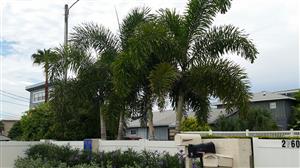
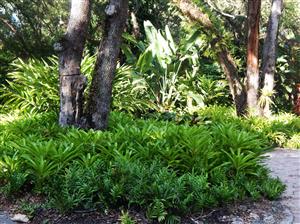

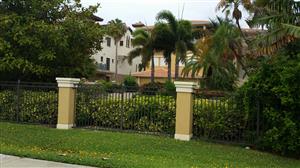
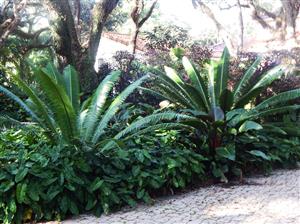
The Jungle Look
Many people just want a “whole bunch of tropical plants everywhere”. It makes them think they are in the tropics while in their own garden. You might be one of those people who prefers the “jungle look” with very dense plantings in your tropical landscape theme garden. This can be very appealing, but is overwhelming for others. This style gives one large trunks next to the walkway and the definite feeling of being in the rain forest. As plants grow overhead, ground levels open up for planting with understory companion plants and shady loving color. If you plan this type of garden, review ultimate size projections for the species utilized so you are not taken by surprise later.
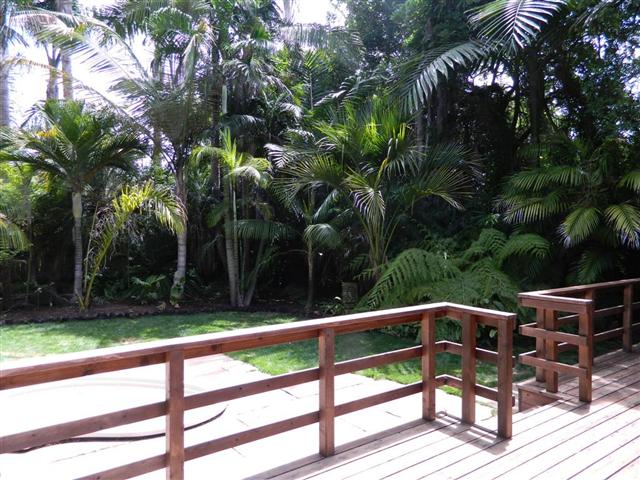
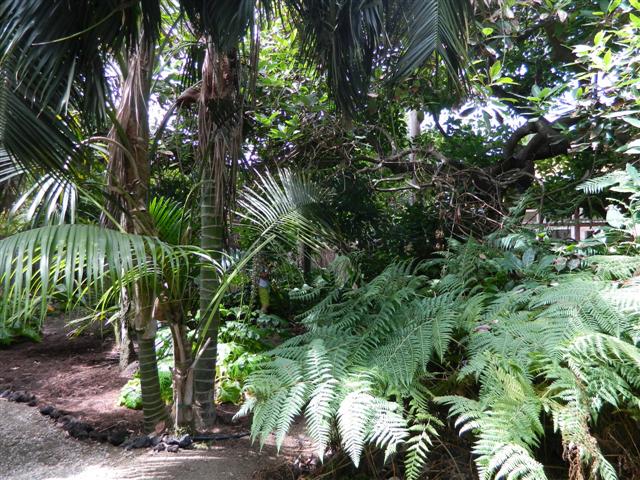
Above you’ll see fairly lush gardens with nice deck and railings
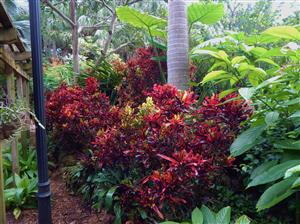
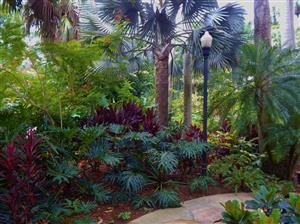
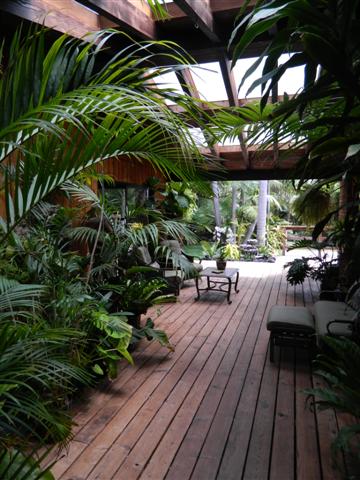
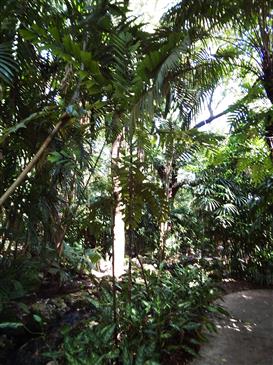

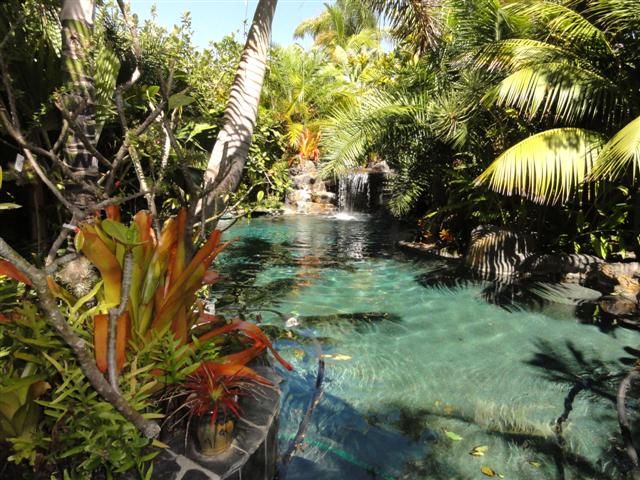
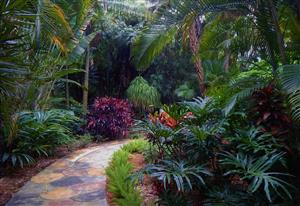

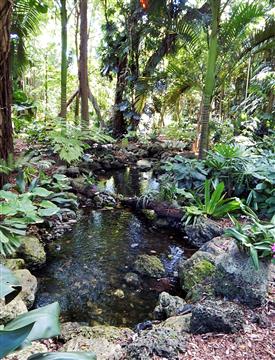
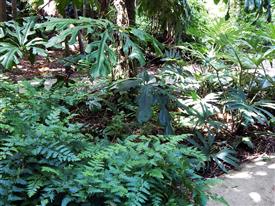
Eventual Height of the Garden
You need to consider the ultimate height of the garden. Of course, culture has something to do with this but it is more determined by the species one puts into the garden. A basic principal of tropical gardens is the canopy. This includes crowns of plants that are overhead. With palms, typically “high” canopy would be above thirty to forty feet or above. “Mid” canopy would be fifteen to thirty feet. Some tropical hardwood trees produce tops of canopies that are well over one hundred feet. The lower canopy or ground plants would be plants that don’t get much overhead. Canopy offers the homeowner protection from cold, cooler summer temperatures, and dappled light near the ground for growing more shade-loving, smaller species. Not only is such filtered light appealing, but it also gives the feeling of being in a tropical rain forest.
Canopy forming genera might include species of Caryota, some Syagrus, Archontophoenix, Washingtonia, some Ravenea and various other palms. Under the canopy in the filtered light, there are many species of palms and cycads and smaller companion plants that one can utilize. Included would be Chamaedorea species, Rhapis, Geonoma, Licuala, and many other exciting smaller plants. And, between the understory plants and the upper canopy rise the mid-story species. Such plants might include Pritchardia , Howea, Rhopalostylis, various Dypsis, Burretiokentia, Chambeyronia, and lots of other beautiful palms. In time, these three layers of understory plants, mid-canopy and upper canopy are quite stunning and very aesthetic. One looks at the ground and it’s beautiful smaller plants, then looks up a bit to see the middle layers of plantings and is immediately drawn upward to the overhead taller plants. It’s a really thrill to see such a garden. It’s beyond the scope of this article to include all the species that would qualify for each layer of this type of garden ( a few have been given above), but there are many choices of palms and cycads to utilize.


Royal Palm and Bismarckia can form upper canopy
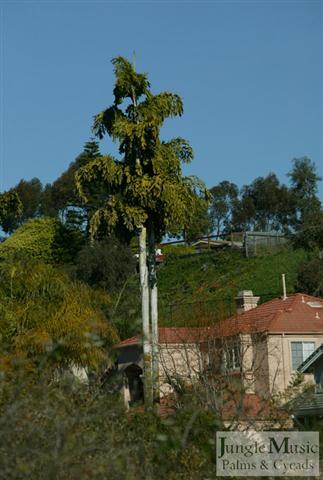
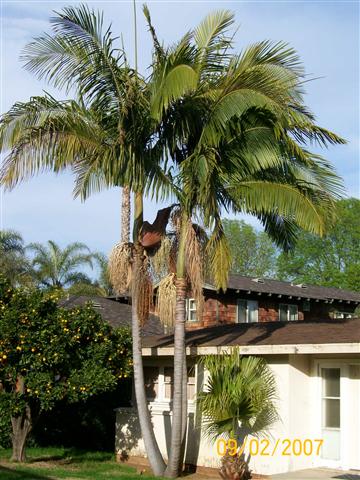
The Fishtail Caryota urens and the King Palm form upper canopy

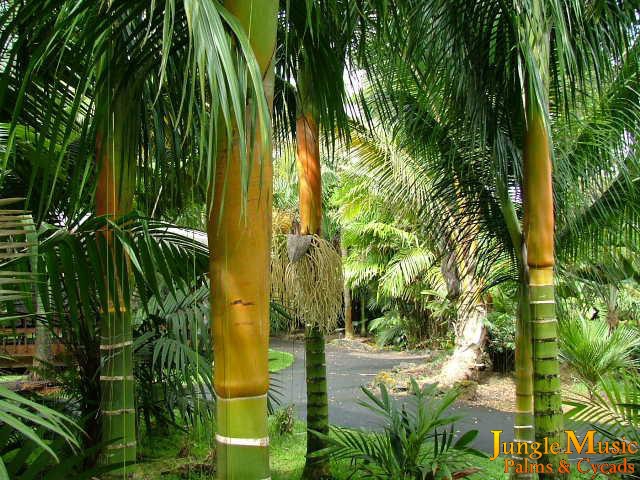
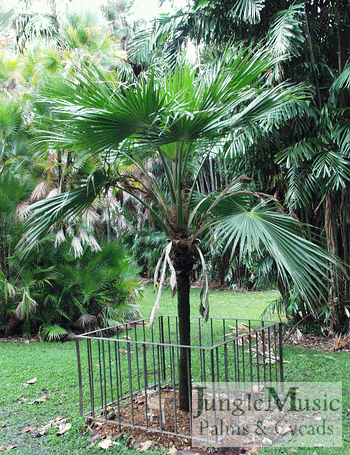
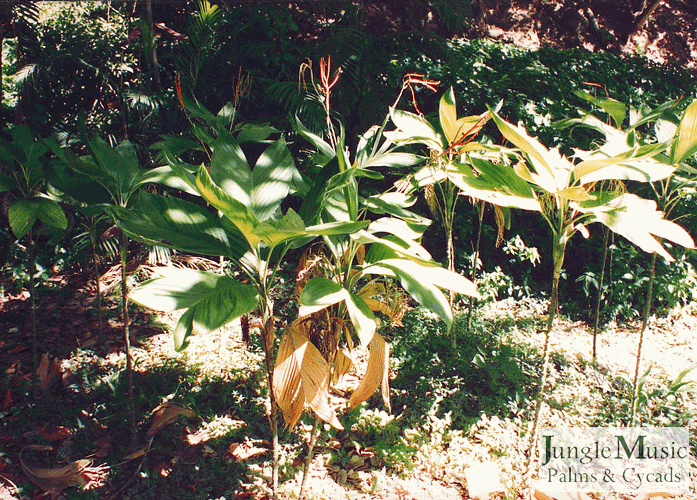
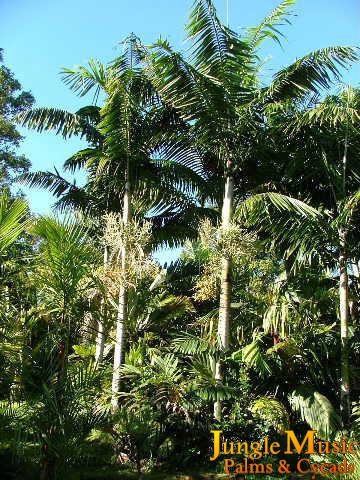
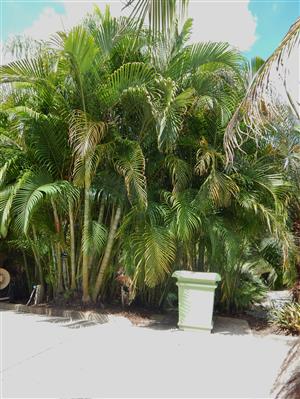
This is a medium sized palm tree.
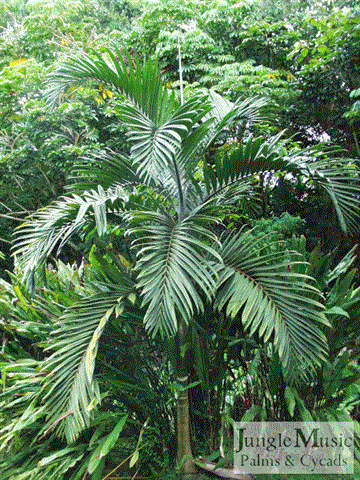
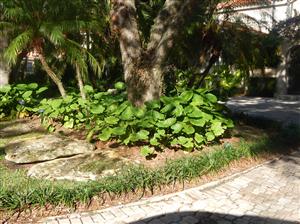
Vary the Species and Utilize Unusual Plants
Another important factor is creating a great tropical garden that shows diversity and something “different” at every point of the garden. Here we are talking about different shapes of leaves, different trunks, different colors, and a whole mixture of plants that gives interest to the garden. Most people have seen the garden where there’s just a whole bunch of Queen Palms, nothing else. You might admire that someone got a very good deal on Queen Palms, but the overall appeal of the garden is lacking. It’s just repetitive and boring.
There are over 3000 species of palms and most are quite different. There are nearly 300 species of cycads. Some palms are huge, while others are tiny. Some have fan leaves. Others have pinnate (feather) leaves. Some sucker (have additional trunks from the base), while others are “single trunked”. Some have “crown shafts” (the slick trunk below the crown), while others have fibrous or hairy trunks. Some palms have blue leaves while others, especially species from Madagascar, offer all colors of the rainbow in their upper trunks and stems. Still other species have beautiful burgundy-red newly emerging leaves. The same is true with cycads. All these differences add a mystique to the garden. The variety of species utilized adds aesthetics to the garden. And, this variety is fun! It is highly advisable that you select from the diverse palate of species that Nature has offered to you.
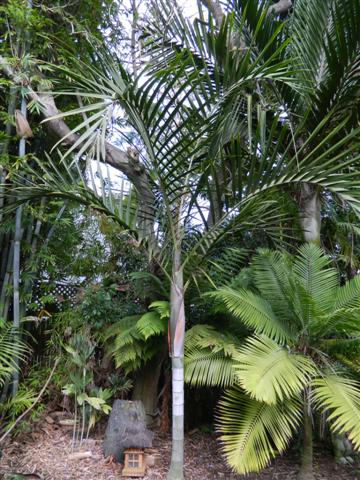
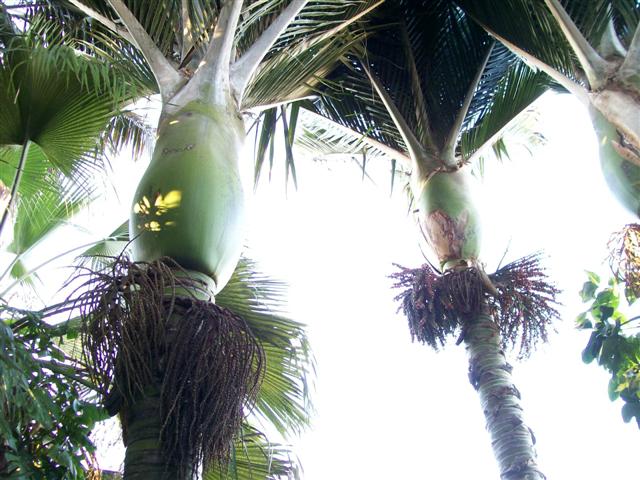
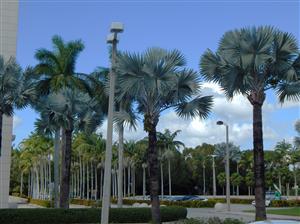
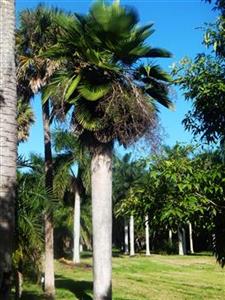
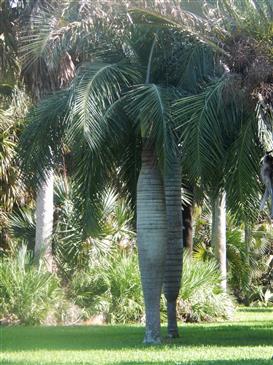
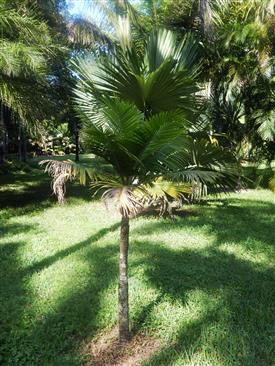
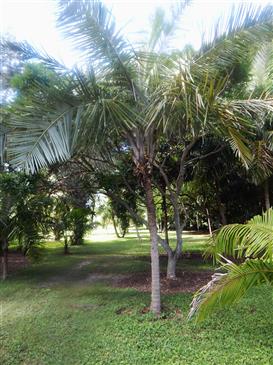
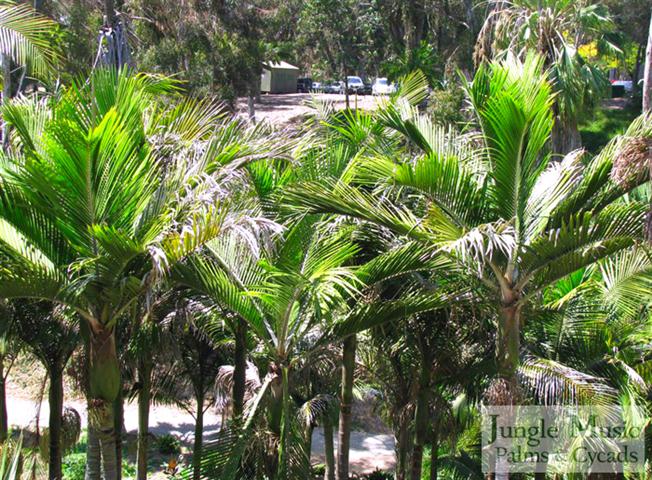
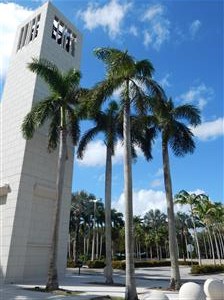
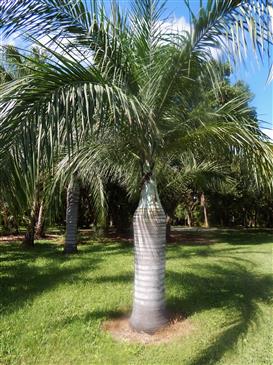
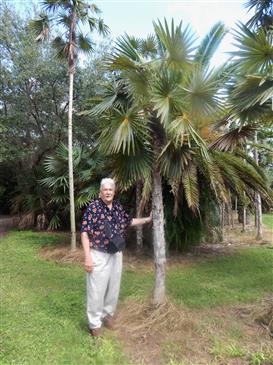

Planting and Layout of Landscape
Additionally important is exactly where to plant each individual plant and how to lay out the different species. Ultimately, it’s always a matter of personal taste. One basic approach is to put larger plants toward the back and have the garden come down in height (smaller species) as it approaches you and the walkway. This allows you to see “everything at once”. But, scattering the big with the little (mixing it up) does have its advantages. In a way, it is more natural. Imagine walking through the garden and a huge trunk is right next to the walkway. And, you walk by and slap it like a watermelon, looking overhead to the canopy. Another rule is to avoid suckering plants that will get large right next to a walkway, a deck, a driveway, etc. These suckering plants block your view of the rest of the garden. You can see past a vertical trunk, but not through a bushy plant. Also, avoid putting spiny or “pokey” plants where they might hurt someone on a path.
Remember not to block a cherished view with your plantings; nor block the view of your neighbors. Also, carefully select plant species that will complement your hardscape. Cycads near a tumbling waterfall are quite striking. Royal Palms following a long curvy driveway are a classic design idea. Some palms can be “trained” to lean out over a pool. If you have large rocks on your property, take advantage of them by planting palms and cycads amongst or between the boulders. Remember to not plant taller species below overhead cables and wires. Also, random planting not utilizing a regular plot is more natural appearing.
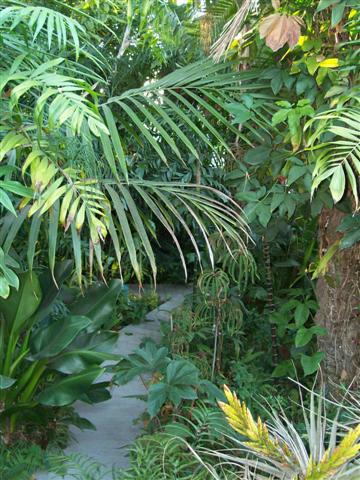

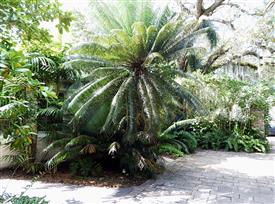


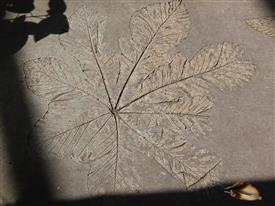
Things to Avoid
Avoid a monotonous, repetitive garden. It is really true that a garden with lots of diversity is more appealing and interesting. I’d highly recommend that you seek out this diversity when you select your planting material. And, a good specialty nursery (such as Jungle Music Palms and Cycads) can typically provide you with such material. “Basement-bargain” plants probably won’t give that award winning look to your creation. But, you still must select species that you actually like. It might take a bit of work, but it can be done. It is best to select well-grown, high quality material, preferably grown in your area.
Regarding planting, avoid at all costs the “grid” or “checkerboard” approach to landscape. This is where plants (often the same species) are planted in lines, all equal distance from each other, all in a row. Such plantings can be appealing if it is done along a long driveway or parkway. But, be careful. It can look very contrived and boring. In the garden, if you plant in perfect rows and columns, the end result will not be appealing. Instead, utilize irregular plantings, groupings, or staggering of species. Another thing to remember is not to plant a species that will get huge right up against the house. Examples would be putting a Phoenix canariensis or Caryota gigas right next to any structure. Also, remember not to put taller species under the eaves of the house. Avoid spiny plants near the front sidewalk. And finally, do not use too many of the same species. Everyone has seen the yard that has nothing but Queen Palms. Yes, this is boring, but the same undesirable effect can result from any species. Vary your plantings with different species, sizes, and shapes.
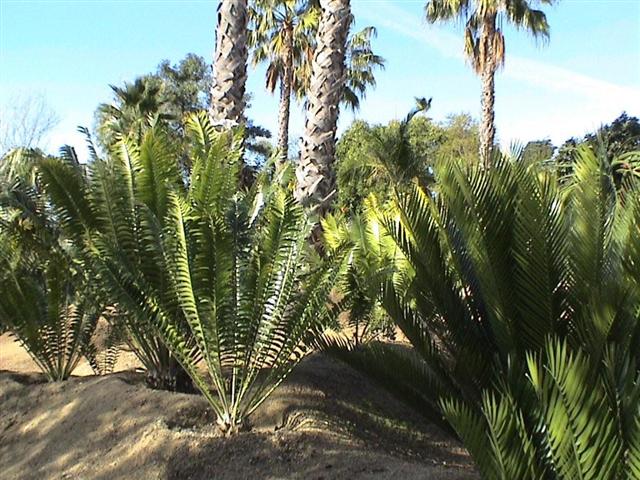
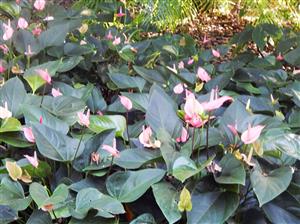

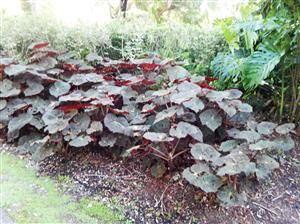
Problem Areas
Every garden has a few areas that seem to perplex the garden “designer”. Examples might include the narrow “slot” between two houses, often with total shade. Or, there’s that ugly area harboring the pool equipment or hiding supplies. Or, that low fence where the neighbors peer over to see you in the spa. Or, that ugly apartment building next door that looks into your yard. To us at the nursery, solving such problems is a daily affair. And, there are particular plants for every situation. There are specific species that thrive in the narrow slot on the north side of the house; others are ideal for hiding the unwanted neighbor or the pool equipment. Still others give privacy to a bedroom window or an ugly wall. Such plant barriers do solve these problems are are a much more attractive than leaving things as they were. And, when done, one forgets about the problems and looks at amazing garden.



Utilizing Cycads
Cycads offer an alternative to palms for those seeking rare tropical plants that don’t get too tall. They can be an important part of tropical landscaping. And, this group of plants is equally as exciting as palms and have a history all their own. Cycads are “Jurassic” plants that have shown little evolution since the time of the dinosaurs. They are quite primitive and at the same time amazingly unique. They come is all shapes, colors, and sizes. They are among the most coveted and rare plants on this planet. Some almost get large enough in time that you would think they are a palm tree. A common misunderstanding is that the Sago Palm is a palm; it is actually a cycad and the term is a misnomer. The Sago Palm is quite commonly used in landscape worldwide. Did you know that there are hundreds of other types of cycads? And, each species is unique in its size and appearance. Their adult sizes ranges from under a foot to over fifty feet tall. Some are spiny; others are smooth. Some are blue ad others green. And, some prefer shade and have the most tropical leaves of any plants. And, they are each different from the other. All are wonderful for the garden and look great under a larger palm or against a wall or structure. Utilizing cycads gives a real touch of “class” to the garden.
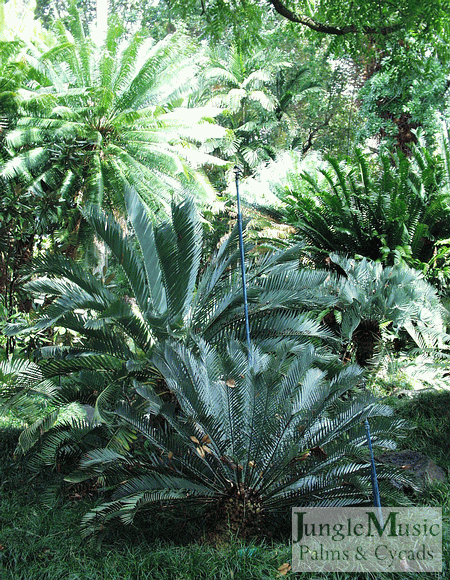
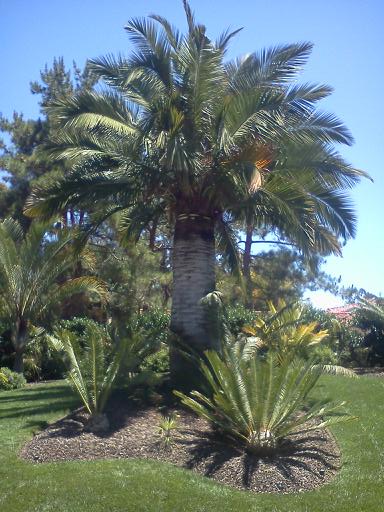
Wine Palm
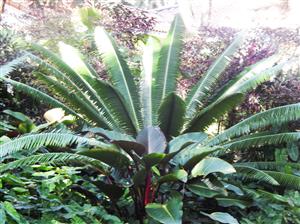

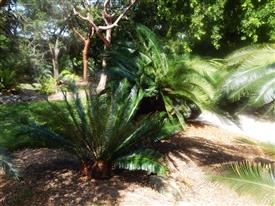
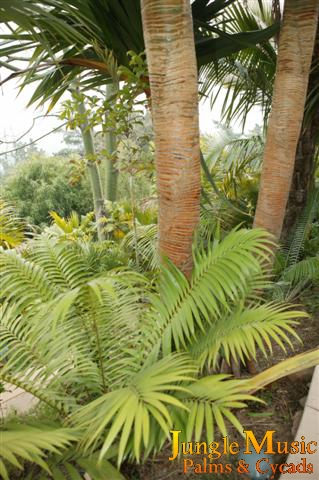

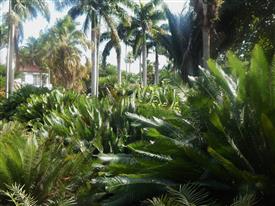

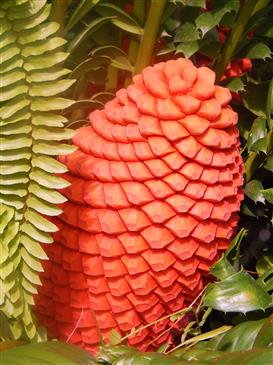
The Companion Plants –
Add Color, Diversity and Interest
Finally, what about all the other “companion plants” that one can add to the garden to create a tropical landscape. Companion plants are typically smaller plants of various types that add diversity, color and interest to the garden, especially on the floor of the garden. These include things such as Ferns, Cycads, Bromeliads, Alocasia, Calocasia, Philodendrons, Anthuriums, Crotons, Ti’s, Impatience, Begonia, and a whole myriad of other colorful and delightful types of plants. What such plantings do is ‘complete” the garden. A well designed garden with proper placement of species with nothing but dirt showing between the plants just doesn’t look right. One could plant a shade-loving lawn, but this creates a lot of unwanted maintenance. Companion plants usually are not high-maintenance. And, the color these plants add to the garden is fantastic. Below I’ve shown some items you could incorporate into your design. For a comprehensive article on tropical companion plants with photos and descriptions of types, click COMPANION PLANTS

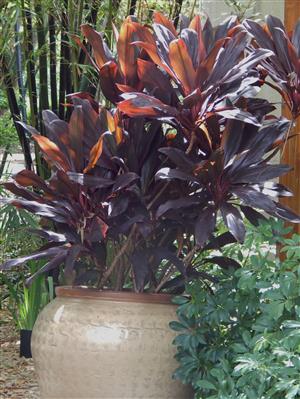

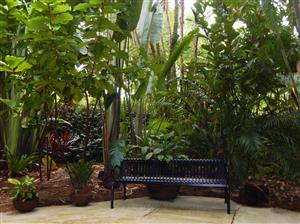
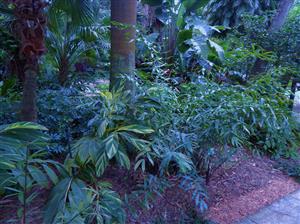
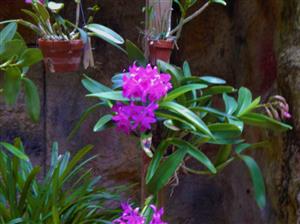
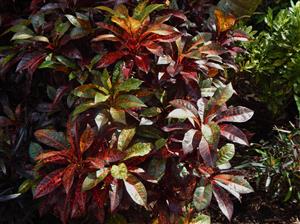
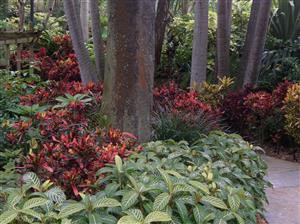
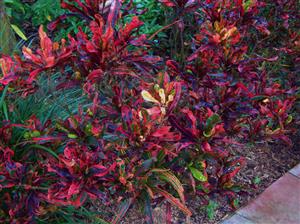
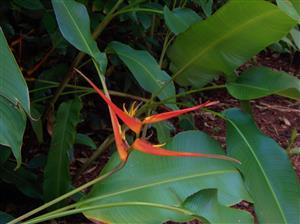
The photos above show a variety of companion plants utilized in an assortment of gardens. Many are quite colorful.
TO SEE A PICTORIAL ONLY PRESENTATION OF MANY DOZENS OF TYPES OF COMPANION PLANTS, CLICK HERE
A Few More Ideas…
There are a few more things that we should mention regarding garden design. The first is to take advantage of what your locality and yard provide to you. If you live in a very hot locality, select species that thrive in the heat. Or, if you are living on a slope going down, select species that are aesthetic to view from above. Cycads would be a great example of this. Or perhaps you have dense shade from a neighbor’s tall trees. There are species of palms that thrive in the shade. If you are lucky enough to have large boulders on your property, take advantage of them. They hold heat and increase the soil temperatures. This can assist in growing many species and cycads love to be planted amongst boulders. All these things help with your tropical landscape design.
Also, consider creating mounds for some of your plantings. Many species like being elevated. This can also be a solution for getting away from overly wet soil conditions. If moisture in the soil is a problem, there are species of palms that love wet soil. Another point is about walkways. These provide access for viewing your garden. Try to make them wide enough for easy passage and don’t be afraid to give them a few bends and turns. Curvy walkways fit nicely into a tropical garden. Adjacent to the walkways is a great place to plant colorful companion plants. Pathways are an important part of the garden design. A final point about tropical garden landscape is to remember that diversity of shapes and sizes, a variety of colors, changes in texture, and utilizing unusual plant qualities adds to the fun and charm of the garden. A new red leaf, a new colorful cycad cone, or broad fan leaves add a final touch that leaves a memorable picture for the viewer of your tropically landscaped garden.

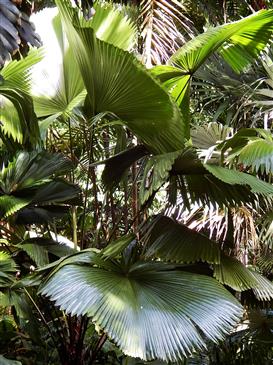


Water Conservation and the Tropical Garden
Yes, it is possible to have a lush tropical appearing garden and yet conserve water. It’s all about using techniques to save water as well as picking the right species to grow. California has recently implemented water restrictions and many are panicked. I’d advise that the enthusiast not change their dream garden but rather plan it out properly and select species that don’t demand as much water. It can be done. Here is a link to an article I’ve written on just this subject:
Water Conservation with Palms and Cycads
Summary
In summary, there are lot of things to consider when creating a tropical garden. But, tropical landscape is not difficult. And, anyone can do it. It just takes some planning and selection of the right species to plant and a good landscape design. At Jungle Music Palms and Cycads, we would love to help you landscape your garden and attain your dreams, whether you’re just getting started or adding a few final plants. We are a tropical plant nursery offering palms, cycads, and other tropical trees. And, we feel confident you will love what you create and before too long be encouraging others to do the same.

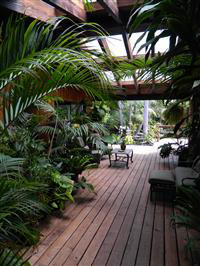
- PALM TREES, CYCADS & TROPICAL PLANT BLOG - October 1, 2020
- TRACHYCARPUS
The Windmill Palm - September 30, 2020 - FAN PALMS –
PALMS WITH CIRCULAR LEAVES - September 29, 2020












